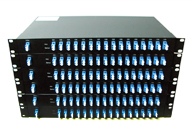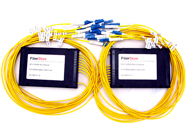What Is WDM
Firstly, we will answer the question: what is WDM?
WDM (Wavelength-division Multiplexing) is the technology of combing a number of wavelengths onto the same fiber simultaneously. A powerful aspect of WDM is that each optical channel can carry any transmission format. WDW increases the capacity of a fiber network dramatically. Thus it is recognized as the Layer 1 transport technology in all tiers of the network. The purpose of this article is to give a brief overview of WDM technology and its applications.
Why We Need WDM?
After knowing ” what is WDM”, it will be easier to figure out what its benefits are.
Due to the rapid growth in telecommunication links, high capacity and faster data transmission rates over farther distances are required. To meet these demands, network managers are relying more and more on fiber optics. Typically, there are three methods for expanding capacity: installing more cables, increasing system bitrate to multiplex more signals and wavelength division multiplexing.
The first method, installing more cables, will be preferred in many cases, especially in metropolitan areas, since fiber has become incredibly inexpensive and installation methods more efficient. But when conduit space is not available or major construction is necessary, this may not be the most cost-effective.
Another way for capacity expansion is to increase system bitrate to multiplex more signals. But increasing system bitrate may not prove cost effective either. Since many systems are already running at SONET OC-48 rates (2.5 GB/s) and upgrading to OC-192 (10 GB/s) is expensive, requires changing out all the electronics in a network, and adds 4 times the capacity, may not be necessary.
Thirdly, the WDM has been proved to be the more cost-effective technology. It does not only support current electronics and fibers but also can share fibers by transmitting channels at different wavelengths (colors) of light. Besides, systems are already using fiber optic amplifiers as repeaters also do not require upgrading for most WDM.
From the above comparison of three methods for expanding capacity, we can easily draw a conclusion that WDM is the best solution to meet the demand for more capacity and faster data transmission rates.
How Does WDM Work?
Knowing “what is WDM” and “why we need WDM” is not enough, we still need to figure out how does it work.
Actually, it is not difficult to understand the operating principle of WDM. Consider the fact that you can see many different colors of light: red, green, yellow, blue, etc. The colors are transmitted through the air together and may mix, but they can be easily separated by using a simple device like a prism. It’s like we separate the “white” light from the sun into a spectrum of colors with the prism. WDM is equivalent to the prism in the operating principle. A WDM system uses a multiplexer at the transmitter to joint the several signals together. At the same time, it uses a demultiplexer at the receiver to split them apart, as shown in the following diagram. With the right type of fiber, it is possible to function as an optical add-drop multiplexer.
This technique was originally demonstrated with optical fiber in the early 80s. The first WDM systems combined only two signals. Modern systems can handle up to 160 signals and can thus expand a basic 10 Gbit/s system over a single fiber pair to over 1.6 Tbit/s. Because WDM systems can expand the capacity of the network and accommodate several generations of technology development in optical infrastructure without having to overhaul the backbone network, they are popular with telecommunications companies.

CWDM VS DWDM
WDM systems are divided into different wavelength patterns: CWDM (Coarse Wavelength Division Multiplexing) and DWDM (Dense Wavelength Division Multiplexing). There are many differences between CWDM and DWDM: spacings, DFB lasers, and transmission distances.
The channel spacings between individual wavelengths transmitted through the same fiber serve as the basis for defining CWDM and DWDM. Typically, the spacing in CWDM systems is 20 nm, while most DWDM systems today offer 0.8 nm (100 GHz) wavelength separation according to the ITU standard. Due to wider CWDM channel spacing, the number of channels (lambdas) available on the same link is significantly reduced, but the optical interface components do not have to be as precise as DWDM components. CWDM equipment is thus significantly cheaper than DWDM equipment.
Both CWDM and DWDM architectures utilize the DFB (Distributed Feedback Lasers). However, CWDM systems use DFB lasers that are not cooled. These systems typically operate from 0 to 70℃ with the laser wavelength drifting about 6 nm over this range. Coupled with the laser wavelength of up to ±3 nm, the wavelength drift yields a total wavelength variation of about ±12 nm. DWDM systems, on the other hand, require the larger cooled DFB lasers, because a semiconductor laser wavelength drifts about 0.08 nm/℃ with temperature. DFB lasers are cooled to stabilize the wavelength from outside the passband of the multiplexer and demultiplexer filters as the temperature fluctuates in DWDM systems.
Due to the unique attributes of CWDM and DWDM, they are deployed for different transmission distances. Typically, CWDM can travel anywhere up to about 160 km. If we need to transmit the data over a long range, the DWDM system is the best choice. DWDM supports 1550 nm wavelength size, which can be amplified to extend transmission distance to hundreds of kilometers.
Conclusion
WDM works by combining and splitting signals in the different systems from telecommunications to imaging systems. There are many WDM products, including CWDM MUX/DEMUX, DWDM MUX/DEMUX, CWDM & DWDM optical add-drop multiplexer, WDM filter, etc. From the above introduction of WDM technology, you can better understand ” what is WDM”, “why we need WDM” as well as WDM’s benefits, work mode, and applications.


Related Articles:




